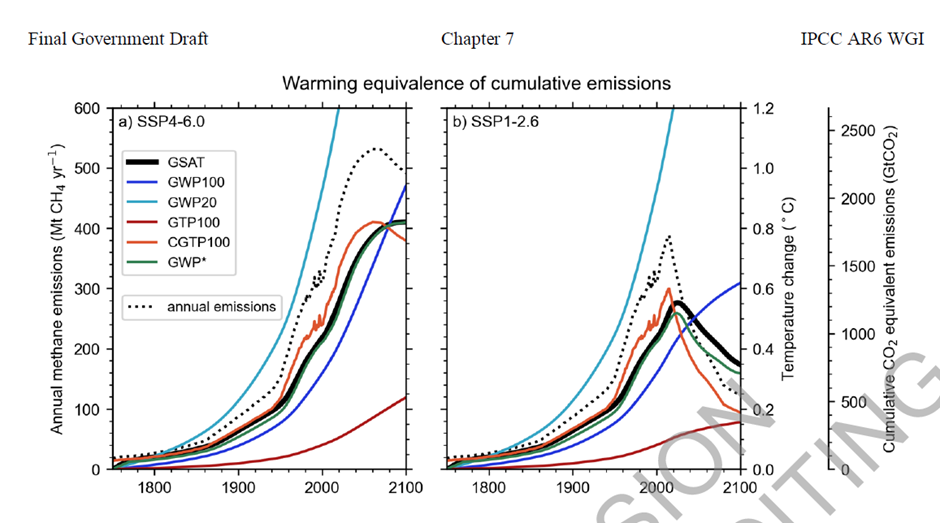IPCC AR6 DISCUSSES THE USE OF 100-YEAR AND 20-YEAR GWPS AND OTHER EMISSION METRICS
Climate Change 2021: The Physical Science Basis discusses a range of emission metrics that are used to model different effects of emissions [1]. The basis of all the emission metrics is the time profile of effective radiative forcing (ERF) following the emission of a particular compound. The emission metrics are then built up by relating the forcing to the desired physical indicators.
Quantification of net zero GHG emissions
The choice of emission metric affects the quantification of net zero GHG emissions and therefore the resulting temperature outcome after net zero emissions are achieved. In general, achieving net zero CO2 emissions and declining non-CO2 radiative forcing would be sufficient to prevent additional human-caused warming. Reaching net zero GHG emissions as quantified by GWP-100 typically results in global temperatures that peak and then decline after net zero GHGs emissions are achieved, though this outcome depends on the relative sequencing of mitigation of short-lived and long-lived species. In contrast, reaching net zero GHG emissions when quantified using new emission metrics such as CGTP or GWP* (definitions are at the end) would lead to approximate temperature stabilization.
Other emission metric can perform better for short-lived greenhouse gases
The 100-year Global Warming Potential (GWP-100) has extensively been employed in climate policy to report emissions of different greenhouse gases on the same scale. If the evolution of the individual GHGs are not known, this can make it difficult to evaluate how a given global multi-gas emission pathway specified only in CO2 equivalent emissions would achieve (or not) global surface temperature goals. This is potentially an issue as Nationally Determined Contributions frequently make commitments in terms of GWP-100 based CO2- equivalent emissions at 2030 without specifying individual gases.
New emission metric approaches such as GWP* and CGTP are designed to relate emission changes in short-lived greenhouse gases to emissions of CO2 as they better account for the different physical behaviors of short and long-lived gases. Using either of these new approaches, or treating short and long-lived GHG emission pathways separately, can improve the quantification of the contribution of emissions to global warming within a cumulative emission framework, compared to approaches that aggregate emissions of GHGs using standard CO2 equivalent emission metrics.
20-year GWPs (GWP-20) quickly overestimate the warming response
Shecco in a recent publication promoted the use of 20-year GWPs: “To take the right decisions, policymakers need to be as informed as possible on the real impact of refrigerants – something that is more accurately reflected in the 20-year GWP metric.” And “Nevertheless, considering the relative short lifetime of synthetic refrigerants in the atmosphere, a shorter horizon, such as 20 years, would much better reflect the true effects of these gases on the climate.” EFCTC issued a short response to this -The contribution of HFCs and HFOs to global warming is well characterised irrespective of 100 years versus 20 years GWPs.
IPCC AR6 discusses the use of a range of emission metrics, including GWP-20 and GWP-100 and how they perform, using methane as an example (its atmospheric lifetime, 11.8 years is similar to HFC-134a, 14 years).

Using methane as an example, Figure 7.22 [Physical Science Basis Chapter 7, illustrated with 2 different emission scenarios] explores how cumulative CO2 equivalent emissions estimated for methane vary under different emission metric choices and how estimates of the global surface air temperature (GSAT) change deduced from these cumulative emissions compare to the actual temperature response computed with the two-layer emulator. Note that GWP and GTP metrics were not designed for use under a cumulative carbon dioxide equivalent emission framework, even if they sometimes are, and analyzing them in this way can give useful insights into their physical properties. Using these standard metrics under such frameworks, the cumulative CO2 equivalent emission associated with methane emissions would continue to rise if methane emissions were substantially reduced but remained above zero. In reality, a decline in methane emissions to a smaller but still positive value could cause a declining warming. GSAT changes estimated with cumulative CO2 equivalent emissions computed with GWP-20 matches the warming trend for a few decades but quickly overestimates the response. Cumulative emissions using GWP-100 perform well when emissions are increasing but not when they are stable or decreasing. Cumulative emissions using GTP-100 consistently underestimate the warming.
Definitions
GSAT - global surface air temperature
GTP - Global Temperature-change Potential
CGTP - This is referred to as a combined-GTP (CGTP) and has units of years (the standard GTP is dimensionless). This CGTP shows less variation with time than the standard GTP and provides a scaling for comparing a change in emission rate (in kg yr-1) of short-lived greenhouse gases with a pulse emission or change in cumulative CO2 emissions (in kg).
GWP* - combines emissions (pulse) and changes in emission levels (step) approaches. The emission component accounts for the need for emissions to decrease to deliver a stable warming. The step (sometimes referred to as flow or rate) term in GWP* accounts for the change in global surface temperature that arises in from a change in short-lived greenhouse gas emission rate, as in CGTP, but here approximated by the change in emissions over the previous 20 years.
GWP - The Global Warming Potential of a refrigerant is defined as the integrated radiative forcing over a "time horizon" of [20,100,500] years following an assumed release of 1 kg, divided by the integrated radiative forcing over the same period from release of 1 kg of carbon dioxide.
For more information about GWPs see the updated LEARN ABOUT…Climate change, global warming & HFCs Selecting and Using GWP values for Refrigerant 2021 September
Reference
[1] IPCC AR6 - Climate Change 2021, The Physical Science Basis - Chapter 7